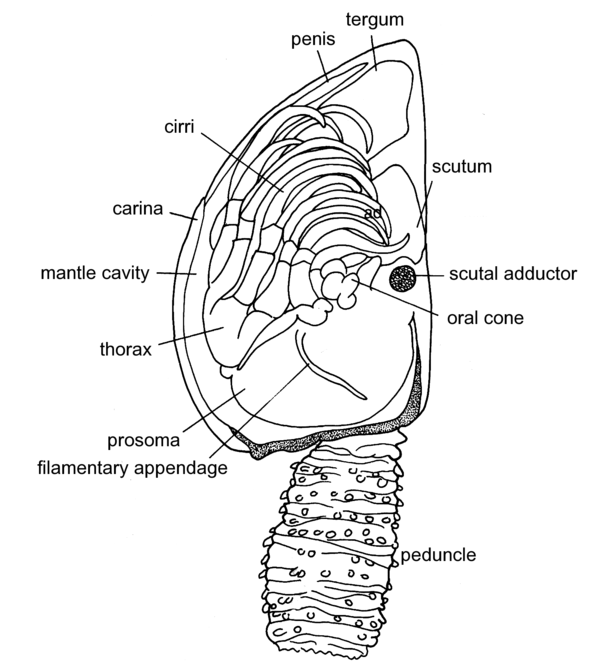- penis
- A papilla on the coxa of the fifth pereiopod or sternite of the male denoting the opening of the genital duct [Ingle, 1983].Male copulatory organ. (May be exceptionally long in some cirripeds.) [Moore and McCormick, 1969].Male copulatory organ; probosciform in hermaphroditic thoracic Cirripedia and greatly distensible. (Pl. penes) [McLaughlin, 1980].(Order Cladocera):Typically unpaired male copulatory structure at end of postabdomen. (single, paired) [Stachowitsch, 1992].(Order Anostraca):One of two eversible male copulatory structures associated with fused first and second abdominal somites (= genital somite). Basically bipartite, consisting of exapnded basal part and apical segment of copulatory part. Vas deferens opens at tip of each penis. (proceeding ventrally close to each other, proceeding ventrolaterally to laterally and widely separated from each other; basal part: rigid, soft and flexible; apical part: with/without spines, serratedenticulate) [Stachowitsch, 1992].(Order Decapoda):Tubular male copulatory structure associated with first segment (coxa) of last pair of pereopods; consists of extensible terminal part of vas deferens and may be variously enclosed in cuticular sheath. Functions in conjunction with modified anterior pleopod pairs. (single, paired). (Syn. sexual tube) [Stachowitsch, 1992].(Order Amphipoda):Pair of relatively small male copulatory structures on ventral surface (sternite) of last (seventh) pereon segment (pereonite), one associated with each vas deferens. (Syn. penis papilla) [Stachowitsch, 1992].(Order Isopoda):In male, paired ventral copulatory papillae (occasionally a single cone) on ventral surface (sternite) of last (seventh) pereon segment (pereonite); transfers sperm to gonopods [Stachowitsch, 1992].(Order Mysida):Pair of male copulatory organs located on ventral surface (sternite) of last (eighth) thoracic somite. (Syn. genital papilla) [Stachowitsch, 1992].(Order Stomatopoda):Elongate male copulatory structure on precoxa of each appendage (thoracopod) of eighth thoracic somite (thoracomere). Sperm ducts and ducts of accessory glands open at tips of penes. (Syn. genital papilla) [Stachowitsch, 1992].(Subclass Cirripedia):(
 ) [Anderson, 1980].Lepas anatifera: left valve removed. [Anderson, 1980](Subclass Cirripedia):(
) [Anderson, 1980].Lepas anatifera: left valve removed. [Anderson, 1980](Subclass Cirripedia):( ) [Anderson, 1980].Lepas anatifera: rostral view; and left valve and cirri removed. [Anderson, 1980](Subclass Cirripedia):Male copulatory organ. In barnacle, located between bases of sixth (= last) pair of thoracic appendages (cirri); in ascothoracican, extends from first abdominal segment. (smooth, annulated; armed, unarmed; with/without basidorsal point). (Syn. intromittent organ) [Stachowitsch, 1992].(Class Ostracoda):Complex, sclerotized copulatory structure in front of caudal rami on posterior end of trunk. Typically bears opening of vas deferens. (paired, unpaired) [Stachowitsch, 1992].(Order Thermosbaenacea):Paired, movable male copulatory organs located on ventral surface (sternite) of last (eighth) thoracic somite [Stachowitsch, 1992].
) [Anderson, 1980].Lepas anatifera: rostral view; and left valve and cirri removed. [Anderson, 1980](Subclass Cirripedia):Male copulatory organ. In barnacle, located between bases of sixth (= last) pair of thoracic appendages (cirri); in ascothoracican, extends from first abdominal segment. (smooth, annulated; armed, unarmed; with/without basidorsal point). (Syn. intromittent organ) [Stachowitsch, 1992].(Class Ostracoda):Complex, sclerotized copulatory structure in front of caudal rami on posterior end of trunk. Typically bears opening of vas deferens. (paired, unpaired) [Stachowitsch, 1992].(Order Thermosbaenacea):Paired, movable male copulatory organs located on ventral surface (sternite) of last (eighth) thoracic somite [Stachowitsch, 1992].
Crustacea glossary. Natural History Museum of Los Angeles County. 2011.
